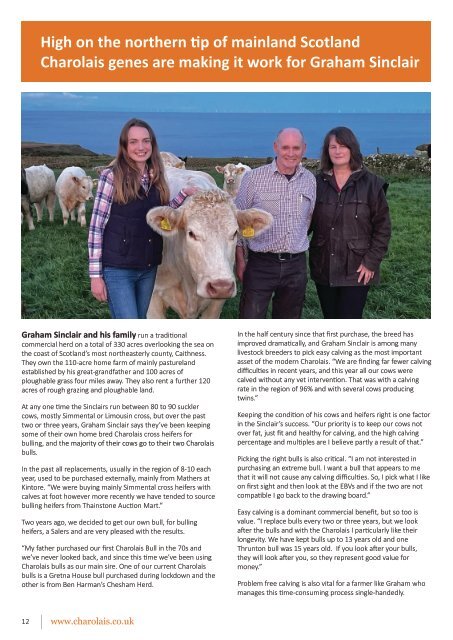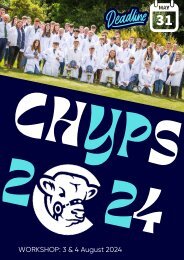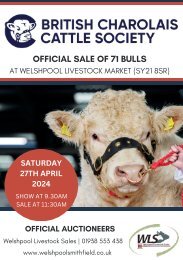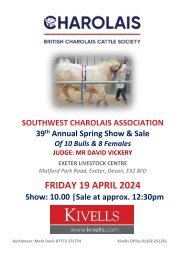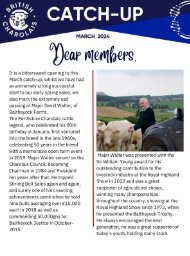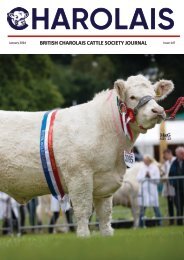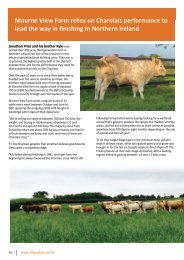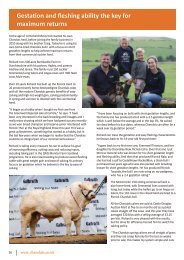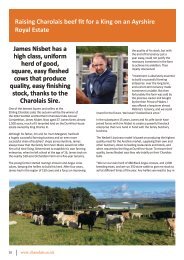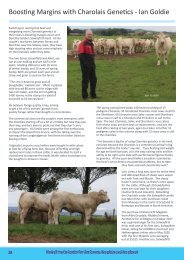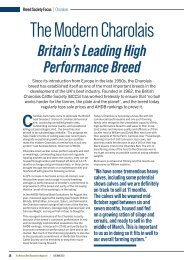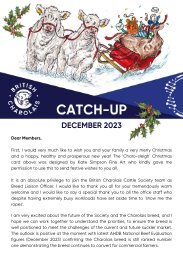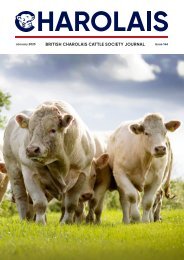You also want an ePaper? Increase the reach of your titles
YUMPU automatically turns print PDFs into web optimized ePapers that Google loves.
High on the northern tip of mainland Scotland<br />
<strong>Charolais</strong> <strong>genes</strong> <strong>are</strong> <strong>making</strong> <strong>it</strong> <strong>work</strong> <strong>for</strong> <strong>Graham</strong> <strong>Sinclair</strong><br />
<strong>Graham</strong> <strong>Sinclair</strong> and his family run a trad<strong>it</strong>ional<br />
commercial herd on a total of 330 acres overlooking the sea on<br />
the coast of Scotland’s most northeasterly county, Ca<strong>it</strong>hness.<br />
They own the 110-acre home farm of mainly pastureland<br />
established by his great-grandfather and 100 acres of<br />
ploughable grass four miles away. They also rent a further 120<br />
acres of rough grazing and ploughable land.<br />
At any one time the <strong>Sinclair</strong>s run between 80 to 90 suckler<br />
cows, mostly Simmental or Limousin cross, but over the past<br />
two or three years, <strong>Graham</strong> <strong>Sinclair</strong> says they’ve been keeping<br />
some of their own home bred <strong>Charolais</strong> cross heifers <strong>for</strong><br />
bulling, and the major<strong>it</strong>y of their cows go to their two <strong>Charolais</strong><br />
bulls.<br />
In the past all replacements, usually in the region of 8-10 each<br />
year, used to be purchased externally, mainly from Mathers at<br />
Kintore. “We were buying mainly Simmental cross heifers w<strong>it</strong>h<br />
calves at foot however more recently we have tended to source<br />
bulling heifers from Thainstone Auction Mart.”<br />
Two years ago, we decided to get our own bull, <strong>for</strong> bulling<br />
heifers, a Salers and <strong>are</strong> very pleased w<strong>it</strong>h the results.<br />
“My father purchased our first <strong>Charolais</strong> Bull in the 70s and<br />
we’ve never looked back, and since this time we’ve been using<br />
<strong>Charolais</strong> bulls as our main sire. One of our current <strong>Charolais</strong><br />
bulls is a Gretna House bull purchased during lockdown and the<br />
other is from Ben Harman’s Chesham Herd.<br />
In the half century since that first purchase, the breed has<br />
improved dramatically, and <strong>Graham</strong> <strong>Sinclair</strong> is among many<br />
livestock breeders to pick easy calving as the most important<br />
asset of the modern <strong>Charolais</strong>. “We <strong>are</strong> finding far fewer calving<br />
difficulties in recent years, and this year all our cows were<br />
calved w<strong>it</strong>hout any vet intervention. That was w<strong>it</strong>h a calving<br />
rate in the region of 96% and w<strong>it</strong>h several cows producing<br />
twins.”<br />
Keeping the cond<strong>it</strong>ion of his cows and heifers right is one factor<br />
in the <strong>Sinclair</strong>’s success. “Our prior<strong>it</strong>y is to keep our cows not<br />
over fat, just f<strong>it</strong> and healthy <strong>for</strong> calving, and the high calving<br />
percentage and multiples <strong>are</strong> I believe partly a result of that.”<br />
Picking the right bulls is also cr<strong>it</strong>ical. “I am not interested in<br />
purchasing an extreme bull. I want a bull that appears to me<br />
that <strong>it</strong> will not cause any calving difficulties. So, I pick what I like<br />
on first sight and then look at the EBVs and if the two <strong>are</strong> not<br />
compatible I go back to the drawing board.”<br />
Easy calving is a dominant commercial benef<strong>it</strong>, but so too is<br />
value. “I replace bulls every two or three years, but we look<br />
after the bulls and w<strong>it</strong>h the <strong>Charolais</strong> I particularly like their<br />
longev<strong>it</strong>y. We have kept bulls up to 13 years old and one<br />
Thrunton bull was 15 years old. If you look after your bulls,<br />
they will look after you, so they represent good value <strong>for</strong><br />
money.”<br />
Problem free calving is also v<strong>it</strong>al <strong>for</strong> a farmer like <strong>Graham</strong> who<br />
manages this time-consuming process single-handedly.<br />
12<br />
www.charolais.co.uk
“I am not looking <strong>for</strong> a tight calving, so we have a lengthy inside<br />
spring calving which starts in earnest in March and ends w<strong>it</strong>h<br />
the cows and calves being out to grass from mid-May onwards.<br />
As I look after all the calving myself, I need to make sure that I<br />
have the time and capac<strong>it</strong>y to calve them and when they have<br />
calved, we like to put them in a pen <strong>for</strong> a week where I can<br />
keep an eye on them be<strong>for</strong>e they join the herd.”<br />
Depending on the weather, the <strong>Sinclair</strong> cows come in from<br />
mid-October to November and <strong>are</strong> kept housed through until<br />
May. Calves <strong>are</strong> weaned a <strong>for</strong>tnight after they come in <strong>for</strong> the<br />
winter when they have settled down, and they <strong>are</strong> fed a Harbro<br />
Champion protein concentrate w<strong>it</strong>h barley and silage. “We<br />
don’t actually weigh them, but they will be in the region of 260<br />
to 280 kilos in the main w<strong>it</strong>h some up to 300.”<br />
<strong>Graham</strong> keeps around three heifer calves each year, “but we<br />
<strong>are</strong> very selective, and they have to be out of a good milky cow<br />
so we only keep the very best.”<br />
Once weaned he will start selling some of the stronger steer<br />
calves, keeping the heifers until the September sales, and<br />
selling all their stock through the Aberdeen & Northern Marts<br />
Livestock Centre at Ca<strong>it</strong>hness.<br />
£280.”<br />
For the <strong>Sinclair</strong>s, farming at the furthest edge of the country,<br />
the pressures of inflation have just the same effect as anywhere<br />
else, and <strong>Graham</strong> is looking <strong>for</strong> optimum per<strong>for</strong>mance w<strong>it</strong>h<br />
minimum inputs from his cattle.<br />
“W<strong>it</strong>h the help of my two daughters, Sarah and Hannah, we<br />
make all our own round bale silage on 110 acres of pasture<br />
to feed the cows until calving but then they’re fed add<strong>it</strong>ional<br />
barley and protein and mineral supplements. We tend not to<br />
push them through the winters. We aim to minimise costs by<br />
letting the grass do <strong>it</strong>s <strong>work</strong> from the spring onwards but when<br />
they go outside, they <strong>are</strong> fed barley from cattle troughs in the<br />
field from about August onwards <strong>for</strong> the sales.”<br />
Even w<strong>it</strong>h the prospect of a decline in feed prices this year,<br />
those overheads represent the biggest challenge at the<br />
moment to this dedicated Ca<strong>it</strong>hness livestock farmer, but<br />
perhaps the <strong>Charolais</strong> per<strong>for</strong>mance is helping to keep the<br />
balance in <strong>Graham</strong> <strong>Sinclair</strong>’s favour.<br />
“I’m a great believer in the live auction mart system,” says<br />
<strong>Graham</strong>, and <strong>it</strong> demonstrates another of the advantages he<br />
believes the <strong>Charolais</strong> gives him. “I love their temperament,<br />
even when we take the cattle to the market, they <strong>are</strong> quiet and<br />
easily handled, and well-natured cattle tend to do well.”<br />
This may contribute to the <strong>Sinclair</strong>s achieving “tremendous<br />
liveweight gain” w<strong>it</strong>h their young stock, and a great year on<br />
year results at the sales in 2023.<br />
“At the first sale in March this year we sold a batch averaging<br />
531 kilos at £3.12 a kilo, mainly to finishers, which gave us<br />
an average per head of £1,660, well up on the previous year,<br />
and in July a batch averaging 564 Kilos sold <strong>for</strong> £1,772. Our<br />
heifers always do comparatively well when we sell them at the<br />
September sale, and this year averaging 508 kilos the price was<br />
£1513 per head, representing £2.98 per kilo, which was well up<br />
on the last year. Having said that, our stirks were up £250 on<br />
the year too, but the heifers outdid them w<strong>it</strong>h an increase of<br />
www.charolais.co.uk 13


